
EANGER IRVING COUSE (American 1866-1936) A PAINTING,
Eanger Irving Couse Sale History
View Price Results for Eanger Irving CouseRelated Paintings
More Items from Eanger Irving Couse
View MoreRecommended Art
View More










Item Details
Description
EANGER IRVING COUSE (American 1866-1936) A PAINTING, "Étaples, Pas-De-Calais, France," oil on canvas, signed L/L. 7" x 9" NOTE: Eanger Irving Couse was born in Saginaw, Michigan in 1866. At a young age, Couse drew the Chippewa Indians near his home, setting the foundation for his lifelong fascination with Native American culture. As a young man, he left Michigan in pursuit of advanced training and better opportunities, first studying at the Chicago Art Institute, then at the National Academy of Design in New York City. While in New York, he proved to be a gifted artist, winning numerous prizes, and by 1886 had entered the Ecole de Beaux Arts in Paris, where he learned much about figure painting, including the habit of posing a model in a crouched or kneeling position close to the picture plane. In 1891, Couse returned to America and traveled to Oregon, where he painted his first Indian portraits of the Klikitat tribe. He then returned to France for several years, but in 1897, came back again to Oregon, built a studio, and concentrated on his Indian paintings. In 1902, he moved to New York and attracted critical praise. The following summer, at the urging of his friend Joseph Sharp, he traveled to New Mexico and rented a house in Taos next door to the studio of Bert Phillips. He spent every summer painting in Taos until 1927, when he finally established a permanent residence there. E. Irving Couse produced a great many paintings of the Pueblo Indians, but he was less interested in historical or ethnographical accuracy than in the portrayal of figures from an artistic standpoint. He was probably the Taos Society member with the highest reputation in his lifetime There is little doubt that Couse cultivated the popularity that came to him through is painting. He clearly wanted to continue to paint the subject that had brought him fame, so he adopted a formula for his Indian painting. Couse was greatly inspired by the Indians of the Taos Pueblo, as well as the brilliant light and colors of the Taos Valley. This influence is apparent in the brighter palette that Couse utilized to illustrate the rich tones and vastness of the New Mexico landscape. The idealized arrangements of the figures in their forest or pueblo settings become almost interchangeable when viewed together as a whole. His Taos Indians inhabit a picturesque world created by the artist; they no longer seem to be noble savages, but noble ornaments. The scenes Couse created suggest that Native Americans were peaceful, dignified human beings and not the savages of Western lore. The quiet, introspective quality of the figures in Couse's works expresses the humanity and nobility of each individual model, a few of which modeled for Couse for decades. Yet, Couse's power as a painter occasionally transcended the limitations of his subject. The paint strokes he used to characterize a body or figure are rich and confident, setting up a rhythmic flow, which moves throughout the work. A typical color scheme of the artist's encompasses a desire to give richness and subdued vibrancy to his settings; earth tones are intermingled with stronger shades of orange-red, slate green, and deep blue so as to enliven the surface without altering the overall stillness of the subject. The generally coarse canvas, thinly painted in the background, helps add a greater sense of depth to the scene. Couse's paintings received tremendous national exposure and made Taos a major tourist attraction. Couse created images that were very influential in changing the public's perception of the West. He was a dedicated and inspired artist who incorporated classical art practices and reinterpreted the West as subject matter. His paintings are still regarded as the most expressive of his time. Couse died in 1936. His works are exhibited at The Metropolitan Museum of Art; the Smithsonian Institution; the Gilcrease Institute of Art; and the Museum of New Mexico, among other public and private collections. Resources: The American West: Legendary Artists of the Frontier, Dr. Rick Stewart,Hawthorne Publishing Company, 1986. Provenance: Estate of the late Charles A. and Betti F. Saunders, Houston, Texas.
Condition
One small chip to the paint is noted, a varnish appears to have been applied, otherwise in very good condition. Simpson Galleries strongly encourages in-person inspection of items by the bidder. Statements by Simpson Galleries regarding the condition of objects are for guidance only and should not be relied upon as statements of fact and do not constitute a representation, warranty, or assumption of liability by Simpson Galleries. All lots offered are sold "AS IS."
**SIMPSON GALLERIES, DOES NOT PROVIDE SHIPPING SERVICES OR SHIPPING QUOTES. WE CAN REFER SUCCESSFUL BIDDERS TO A NATIONAL/INTERNATIONAL SHIPPER** Shipping may be secured through one of these shippers or your preferred shipper. The UPS Store 5233 Bellaire Blvd. Bellaire, TX 77401 (713) 667-5116 Email: store2567@theupsstore.com, ACTS Crating & Transportation Services (713) 869-2269 Email: crating@actsintl.com, or LDG Delivery Service (561) 212-7159 Email: antiquedelivery@aol.com.
**SIMPSON GALLERIES, DOES NOT PROVIDE SHIPPING SERVICES OR SHIPPING QUOTES. WE CAN REFER SUCCESSFUL BIDDERS TO A NATIONAL/INTERNATIONAL SHIPPER** Shipping may be secured through one of these shippers or your preferred shipper. The UPS Store 5233 Bellaire Blvd. Bellaire, TX 77401 (713) 667-5116 Email: store2567@theupsstore.com, ACTS Crating & Transportation Services (713) 869-2269 Email: crating@actsintl.com, or LDG Delivery Service (561) 212-7159 Email: antiquedelivery@aol.com.
Buyer's Premium
- 22.5% up to $1,000,000.00
- 22.5% above $1,000,000.00
EANGER IRVING COUSE (American 1866-1936) A PAINTING,
Estimate $1,500 - $2,500
20 bidders are watching this item.
Shipping & Pickup Options
Item located in Houston, TX, usSee Policy for Shipping
Payment

TOP





















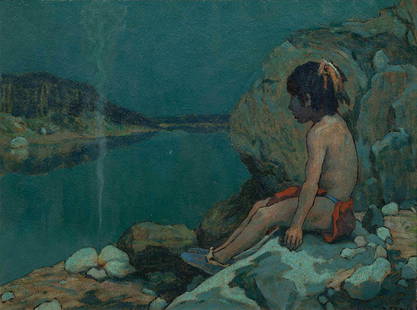
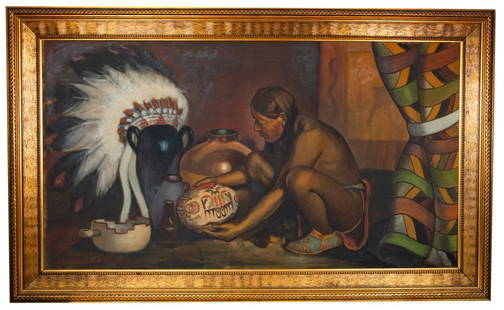
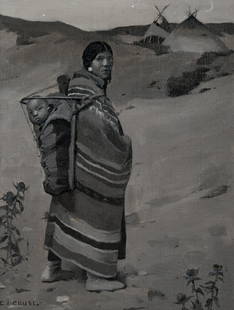
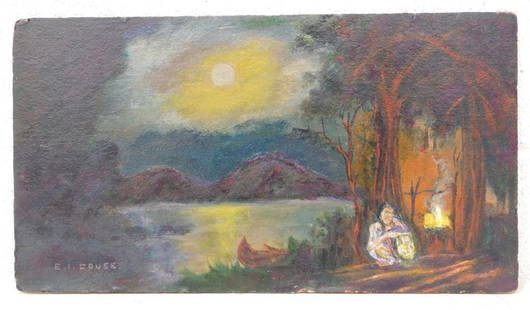
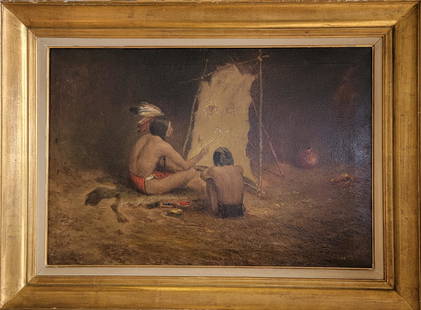
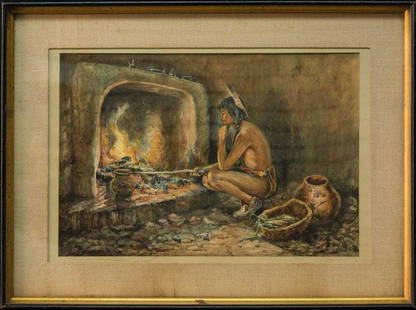






![LON MEGARGEE (1883-1960) NATIVE AMERICAN PAINTING: Framed oil on canvas painting, "The Song of the Flute," signed lower right L. Megargee (Alonzo [Lon] Megargee III, American, 1883-1960), titled verso, sight: 17.5"h, 27.5"w, overall: 22"h, 32"w, 4.5lb](https://p1.liveauctioneers.com/21/213605/109197079_1_x.jpg?height=310&quality=70&version=1628699347)


































